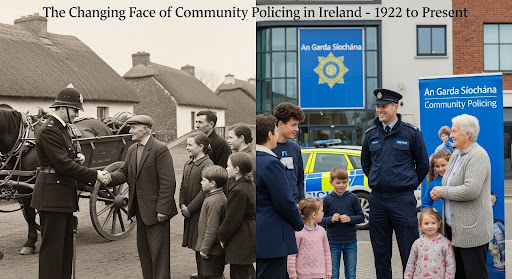As a historian with a deep interest in Ireland’s police force, I’ve spent decades studying how An Garda Síochána has evolved since its formation. Today, I’d like to take you through this fascinating journey of Ireland’s unique approach to policing.
The Birth of An Garda Síochána (1922-1930s)
Following the Anglo-Irish Treaty and the birth of the Irish Free State, An Garda Síochána (Guardians of the Peace) was established on February 22, 1922. Unlike the heavily armed Royal Irish Constabulary it replaced, our new police force was deliberately unarmed – a revolutionary concept at the time and a bold statement of Ireland’s commitment to civil rather than military policing.
The first Commissioner, Michael Staines, famously stated: “The Garda Síochána will succeed not by force of arms or numbers, but on their moral authority as servants of the people.” This philosophy has remained at the heart of Irish policing for over a century now.
The Middle Years: Building Trust (1930s-1960s)
During these formative decades, the Gardaí established themselves as fixtures in local communities. The village Garda on his bicycle became an iconic image – knowing everyone by name, settling local disputes, and serving as both an authority figure and a neighbour.
I often interview retired Gardaí from this era who recall the importance of being seen in the community, attending local GAA matches, and understanding the specific challenges of their assigned areas. One sergeant told me how he would spend evenings in different public houses – not drinking, but listening to local concerns and gathering intelligence.
Modernisation and The Troubles (1970s-1990s)
The outbreak of The Troubles presented unprecedented challenges. The Garda needed to balance community policing with security operations, particularly in border counties. This period saw increased armament of special units and a more visible security presence.
Despite these pressures, community policing innovations emerged. The Neighbourhood Watch scheme was introduced in 1985, followed by Community Alert in rural areas. These programs represented early formal recognition of the importance of community partnership in effective policing.
The Celtic Tiger and After (1990s-2008)
Ireland’s economic boom brought new challenges – increased urbanisation, cultural diversity through immigration, and new forms of crime. The Garda responded with initiatives like the Garda Youth Diversion Projects and the establishment of dedicated Ethnic Liaison Officers.
However, rapid social change strained the traditional community policing model. In some rapidly expanding suburbs, Gardaí struggled to maintain the close community connections that had been the hallmark of Irish policing.
Reform and Renewal (2008-Present)
Following the economic crash and several high-profile controversies, the Garda underwent significant reform. The Garda Síochána Act 2005 established the Garda Síochána Ombudsman Commission (GSOC), and the 2015 Strategic Transformation Program emphasised a return to core community policing principles.
The 2018 Commission on the Future of Policing in Ireland recommended a “new community policing model” that would place problem-solving at the local level at the heart of all Garda activity. Recent years have seen the implementation of many of these recommendations, including the divisional policing model and increased focus on local service delivery.
Digital Community Policing
Perhaps most interesting has been watching how community policing has adapted to the digital age. The Garda now maintains active social media accounts, uses text alert systems, and has developed a mobile app. These digital tools extend the principle of visibility and accessibility into online spaces where much of community life now takes place.
Reflections on a Century of Community Policing
As we reflect on 100+ years of An Garda Síochána, it’s clear that while methods have evolved, the core philosophy remains remarkably consistent with Commissioner Staines’ original vision – policing by consent and moral authority rather than force.
The challenges facing modern Gardaí are substantial – from cybercrime to policing increasingly diverse communities. Yet the bedrock principles of knowing your community, being visible within it, and earning its trust remain as relevant in 2025 as they were in 1922.
Written by Sean Daly Garda

